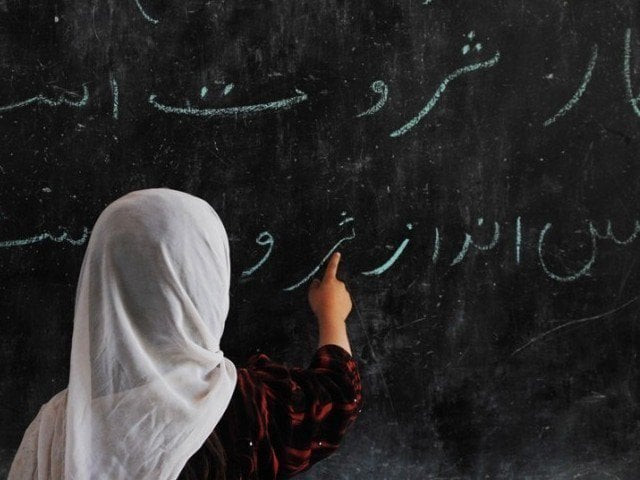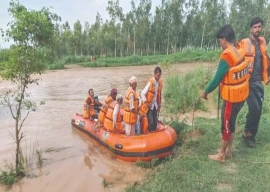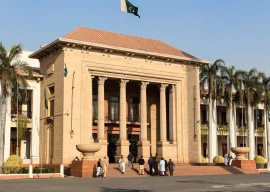
This was disclosed as the Pakistan Education Statistics 2016-17 — education data compiled by the Academy of Educational Planning and Management (AEPAM), a research and training organisation working under the of Ministry of Federal Education and Professional Training — was launched in the capital on Thursday.
HEC emphasises role of science education in economic development
The report, which used old data estimates, stated there are currently around 51.53 million children in Pakistan between five-years-of-age and 16-years-of-age.
Among this group, only 28.68 million children are attending schools from pre-primary up to higher secondary in both public and private sectors. This leaves 22.84 million children out of school.
The report found that from 2012-13 to 2016-17, around 5.21 million more children were able to go to schools as enrollment in classes I-XII increased. Moreover, there was also a decline of around 3.11 million children in the out-of-school children (OOSC) column for Pakistan over the past four years, despite a population increase of 1.22 million during this time.
Despite that, around 44 per cent of the country’s child population is not going to schools.
A province wise breakdown of the data showed that Balochistan is the home to the largest segment of children not in school, with 70 per cent of its child population not in classrooms.
It was followed by the erstwhile Federally Administered Tribal Areas (Fata) where 57 per cent of the children population is not in schools.
Other areas of the country also present poor numbers with Sindh another which does not have a majority of its child population, or 52 per cent, in school.
Remote, mountainous regions of Gilgit-Baltistan (G-B) and Azad Jammu and Kashmir (AJK) follow with 47 per cent of the child population in each region out of school. Punjab too has 40 per cent of its children out of schools.
Khyber-Pakhtunkhwa (K-P), where the provincial government had claimed to make education a priority during the review period, 34 per cent of its child population was not in school.
The federal capital, despite boasting to be the seat of power of the country, had 12 per cent of its child population not going to school.
The report found that there are 5.06 million children of primary-school going age who are currently out of school.
In the middle, high and higher secondary level, the number of out of school children are 6.51 million, 4.97 million and 6.29 million respectively.
Gender-wise, more girls are out of school than the boys.
In the primary to the higher secondary school level, 49 per cent of the population or 12.16 million children do not go to schools. By comparison, 40 per cent of the boys, around 10.68 million boys, do not go to school.
The gender disparity is particularly stark in conservative and underprivileged regions such as Fata, K-P and Balochistan.
Focus education: Higher education minister makes expansionist claims
Thin in the middle
The report showed an alarming trend that child enrollment and teacher hiring drops drastically after the primary stage.
The Adjusted Net Enrolment Rate (ANER) of children from five-years-of-age to nine-years-of-age at the primary stage is 77 per cent. This drops to a worrying 49 per cent at the middle and 31 per cent at the high and higher secondary stage respectively.
Similarly, for teachers, it showed that there were more teachers for the primary and the higher levels compared to middle school. Figures for 2016-17 showed that there were 486,903 teachers for the primary level, including pre-primary, mosque schools and informal level. At the middle school level, only 455,445 teachers available. At the high level, 560,642 teachers were available.
This figure though further whittled down at the higher secondary level to just 120,336 teachers.
Moreover, the survival rate in grade-Vis 67 per cent while the transition rate from primary to middle level is 84 per cent.
Surprisingly, girls enrolment at the higher secondary stage in the public sector has increased by 77 per cent over the past four years.
Teaching woes
Regarding facilities at schools, the report highlighted that 26 per cent of public sector primary schools are operating with a single teacher while 18 per cent of public sector primary schools are operating with a single classroom.
The report, though, also notes significant improvement in government school facilities over the past five years with electricity provision increasing in 20 per cent of school, drinking water facility increased in 13 per cent of schools, toilets in 23 per cent of schools and boundary walls in 12 per cent of schools.
The schools with the least facilities available were AJK and Balochistan. Islamabad had the most facilities available with electricity in 99.8 per cent of schools. It was followed by Punjab which fell short in electricity but surpassed the capital in the provision of drinking water and toilets. It was followed by K-P.
Sindh, though, lagged behind where less than half of all public schools — or 45.2 per cent having power, only 57.2 per cent having drinking water, 63.5 per cent having toilets and 61.4 per cent having boundary walls.
The report noted that apart from improving the availability of facilities in a government school, a lot still needs to be accomplished since 32 per cent of schools are still operating without electricity, 22 per cent are without drinking water, 22 per cent are without toilets and 21 per cent are without boundary walls.
The report highlights there are some 32,272 Madressahs in Pakistan enrolling some 2.26 million students with 79,289 teachers.
4% of GDP demanded for education
Despite many shortcomings, the reports say it is heartening to see the visible improvements in the overall education sector, the education system of Pakistan is comprised of 317,323 institutions more than half of the public institutions accommodating 50.29 million students with the assistance of 1.84 million teachers.
Quoting two different surveys the report not having the latest data puts the literacy rate at 60 to 61 per cent in 2014-15 with youth literacy rate at 72 per cent.
Published in The Express Tribune, July 6th, 2018.


















COMMENTS
Comments are moderated and generally will be posted if they are on-topic and not abusive.
For more information, please see our Comments FAQ